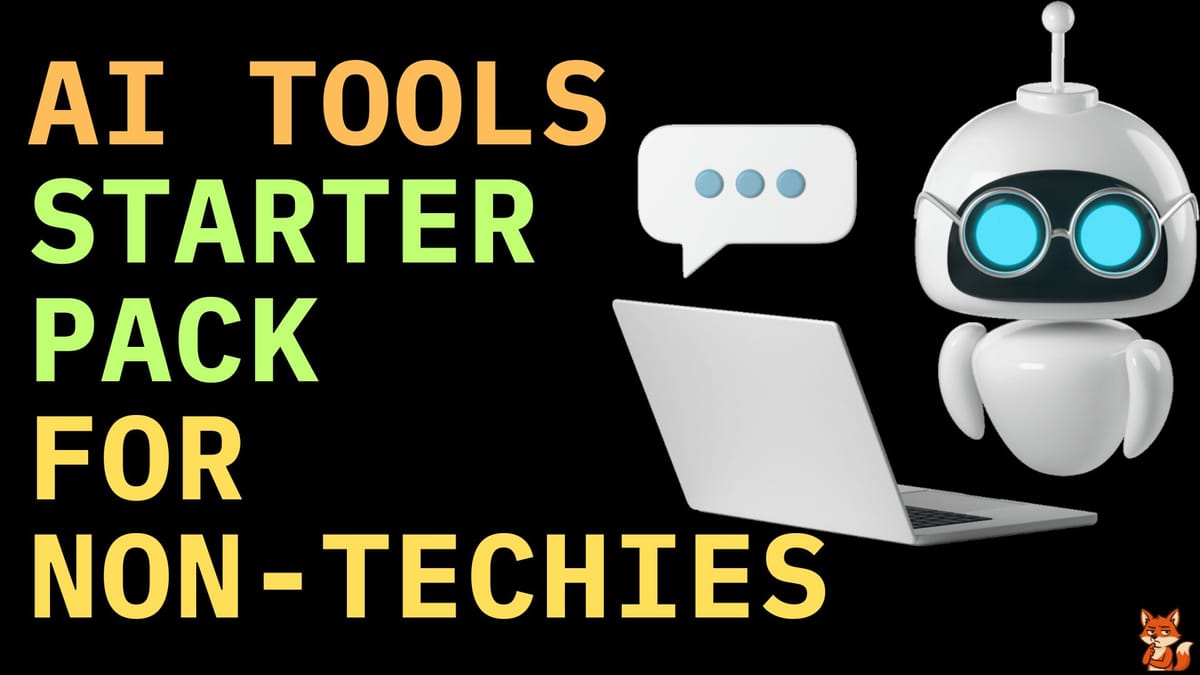Starter Pack: AI Tools for People Who Break Computers by Existing
Everyone's raving about AI, but you still Google 'how to PDF'? Just the AI tools that actually save many hours a week for people who think ChatGPT is a fancy calculator.

Everyone's raving about AI, but you still Google "how to PDF"?
You're not alone. While tech bros are building AI empires, the rest of us are just trying to figure out why our printer hates us.
But here's the thing: AI tools aren't just for people who speak in code. They're for humans who want to get stuff done faster without learning rocket science.
Zero fluff. Just the AI tools that actually save me 10+ hours/week. If I can figure them out while my WiFi randomly disconnects and my laptop makes weird noises, so can you.
Why AI Doesn't Have to Be Scary
The guru narrative: "AI will revolutionize everything! Learn to prompt engineer or become obsolete!"
The reality: Most AI tools are just brilliant assistants that help you do everyday human things better.
Think of AI like a microwave. You don't need to understand electromagnetic radiation to heat up leftovers. You need to know which buttons make food warm.
Level 1: Your Gateway Drugs (Start Here)
ChatGPT - Your Overthinking Assistant
What it actually does: Answers questions, writes stuff, explains things like you're 12
Cost: Free (with some daily limits), $20/month for the good stuff
Perfect for: People who overthink everything and need a rubber duck that talks back
Your first missions:
- "Explain [complicated thing] like I'm explaining it to my confused aunt"
- "Write a professional email saying no to [thing you don't want to do]"
- "Give me 5 ideas for [whatever you're stuck on]"
Non-techie hack: Talk to it like a slightly smarter friend, not a computer. Say "please" and "thank you" - it doesn't care, but you'll feel better.
Reality check: It sometimes makes stuff up confidently. Always fact-check important things.
Grammarly - Your Grammar Bodyguard
What it actually does: Fixes your writing before you embarrass yourself
Cost: Free version catches most disasters, $12/month for the fancy stuff
Perfect for: People who write "your welcome" and immediately regret it
Set it up once: Download the browser extension, let it lurk in your text boxes, never think about apostrophes again.
Why it's brilliant: Works everywhere you type. Emails, social media, that angry text you're about to send - it's got your back.
Advanced move: The tone detector alerts you when your email comes across as passive-aggressive (spoiler: it's always perceived as such).
Level 2: Getting Actually Useful
Canva Magic Design - Design for Design-Challenged Humans
What it actually does: Makes professional-looking graphics from terrible descriptions
Cost: Free for basic magic, $15/month for premium magic
Perfect for: People whose idea of design is Comic Sans in rainbow colors
Magic prompt formula: "Create a [thing] for [purpose] that doesn't look like a 5-year-old made it"
Real example: "Instagram post about my small business that makes me look professional but not corporate"
Why it's addictive: You describe what you want badly, and it shows you something that looks good. It's like having a designer friend who never judges your aesthetic choices.
Notion AI - Your Chaotic Thoughts, Organized
What it actually does: Takes your brain dump and makes it look like you have your life together
Cost: $8/month (includes the whole Notion workspace)
Perfect for: People whose notes look like a crime scene
The magic workflow:
- Vomit all your thoughts onto a page
- Ask Notion AI to "organize this mess into something useful"
- Watch it create action items, priorities, and structure
- Feel like a productivity guru
Real-world win: Turn meeting notes into actual follow-up tasks without manually sorting through your terrible handwriting.
Level 3: Now You're Cooking With Gas
Otter.ai - Meeting Notes for People Who Zone Out
What it actually does: Records meetings, transcribes everything, tells you what you missed.
Cost: Free for 600 minutes/month, $17/month for unlimited
Perfect for: People who nod along in meetings while thinking about lunch
How to use it: Invite Otter to your Zoom calls, let it take notes while you actually participate (or continue thinking about lunch).
The magic: Get a full transcript + summary + action items without frantically scribbling notes that you can't read later.
Bonus: Share the summary with people who missed the meeting and appear to be the most organized person in the room.
Claude (Anthropic) - ChatGPT's Thoughtful Cousin
What it actually does: Like ChatGPT but better at long-form thinking and less likely to hallucinate
Cost: Free tier available, $20/month for Claude Pro
Perfect for: People who need help with complex analysis or writing longer content
When to use Claude instead of ChatGPT:
- Writing anything longer than an email
- Analyzing documents or data
- When you need it to actually think through problems step-by-step
Pro tip: Upload PDFs and ask it to summarize, analyze, or answer questions about them. It's like having a research assistant who actually reads the whole thing.
Level 4: Feeling Fancy Now
Zapier AI - Automation for Lazy Geniuses
What it actually does: Connects your apps so they talk to each other without you
Cost: Free for basic automation, $20/month for more complex magic
Perfect for: People who do the same digital tasks repeatedly and hate it
Beginner automations that will blow your mind:
- "When I get an email with an attachment, save it to Google Drive."
- "When someone fills out my contact form, add them to my email list."
- "When I post on Instagram, also post it to Facebook."
The setup: Use their templates, change the apps to yours, and watch your repetitive tasks disappear.
Reality check: Start with one simple automation. Don't try to automate your entire life on day one.
MidJourney - Image Creation for Non-Artists
What it actually does: Creates images from your terrible descriptions
Cost: $10/month basic plan
Learning curve: Medium (requires Discord), but worth it
How to not suck at it:
- Be specific: "A cozy coffee shop with plants" not "nice place"
- Add style: "in watercolor style" or "like a professional photograph"
- Iterate: If it's close but not right, ask for variations
Real use cases Include Social media graphics, presentation images, concept visualization, or sing cool art to feel creative.
Your 30-Day AI Adoption Plan
Week 1: Foundation
- Set up ChatGPT and Grammarly
- Use ChatGPT for one daily task (email writing, brainstorming, etc.)
- Let Grammarly fix your writing everywhere
Week 2: Visual & Organization
- Add Canva Magic Design to your toolkit
- Try Notion AI for organizing one chaotic project
- Create your first AI-designed social media post
Week 3: Meetings & Analysis
- Use Otter.ai for one important meeting
- Try Claude for analyzing a document or planning something complex
- Compare ChatGPT vs Claude for your specific needs
Week 4: Automation & Advanced
- Set up your first Zapier automation
- Experiment with Midjourney if visual content matters to you
- Identify your next AI tool based on your most significant time wasters
How to Not Look Like an AI Noob
Don't:
- Ask AI to do everything for you
- Share sensitive information with AI tools
- Trust AI outputs without reviewing them
- Expect perfection on the first try
Do:
- Edit AI outputs to match your voice
- Use AI as a starting point, not the finish line
- Learn each tool's strengths and weaknesses
- Stay curious but skeptical
The Anti-Guru Reality Check
I'm not going to tell you AI will change your life overnight. It won't. It's just really good at handling the boring stuff so you can focus on the human stuff.
I'm not going to promise you'll become an AI expert. You don't need to be. You just need to know which buttons to push to get your work done faster.
I'm not going to sell you a course about prompt engineering. Most AI tools work fine with normal human language. Talk to them like you'd talk to a smart intern.
Your Next Steps (Do This Today)
- Pick ONE tool from Level 1 and sign up
- Try it for ONE specific task you do regularly
- Use it for a week before adding another tool
- Track the time saved (you'll be surprised)
Advanced mission: Once you're comfortable with 2-3 tools, identify your biggest time-waster and find an AI tool that addresses it.
The Bottom Line
AI tools aren't magic. They're just really good at pattern recognition and language processing.
You don't need to understand how they work any more than you need to understand how Netflix recommends shows. You just need to know which ones solve your actual problems.
Stop overthinking it. Start using it.
Your future self will thank you when you're getting twice as much done in half the time, while everyone else is still arguing about whether AI is going to take over the world.
Which AI tool are you going to try first? Get in touch to share your results - I love hearing about people's first AI wins (and epic fails).
Ready for more productivity upgrades? Check out our automation starter pack or learn about focus tools for scattered brains to keep building your efficiency empire.
